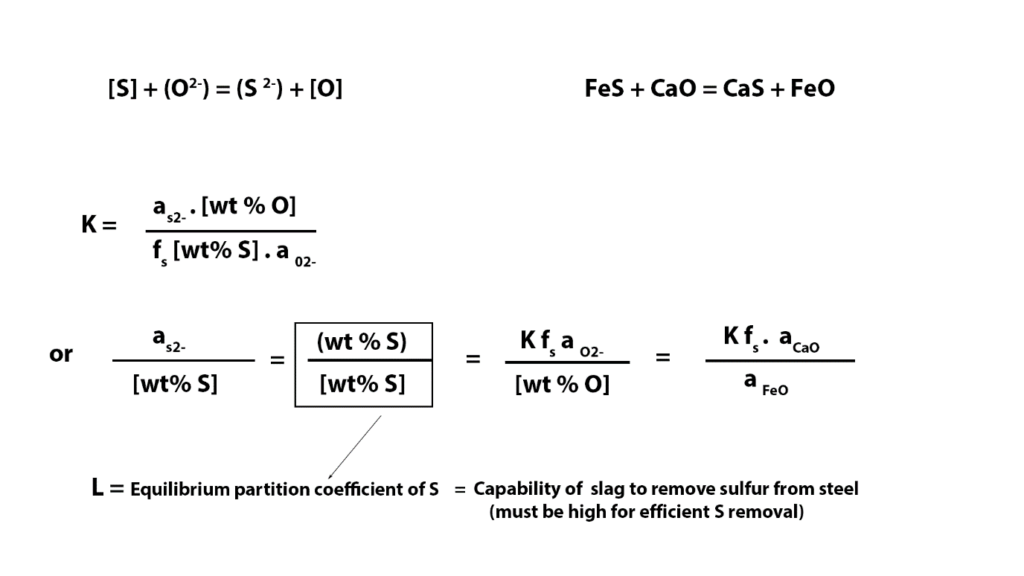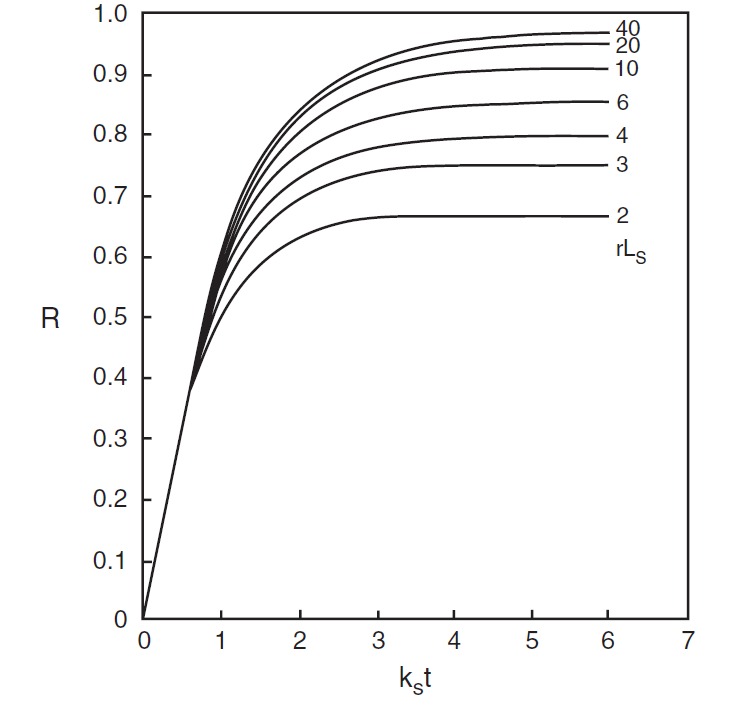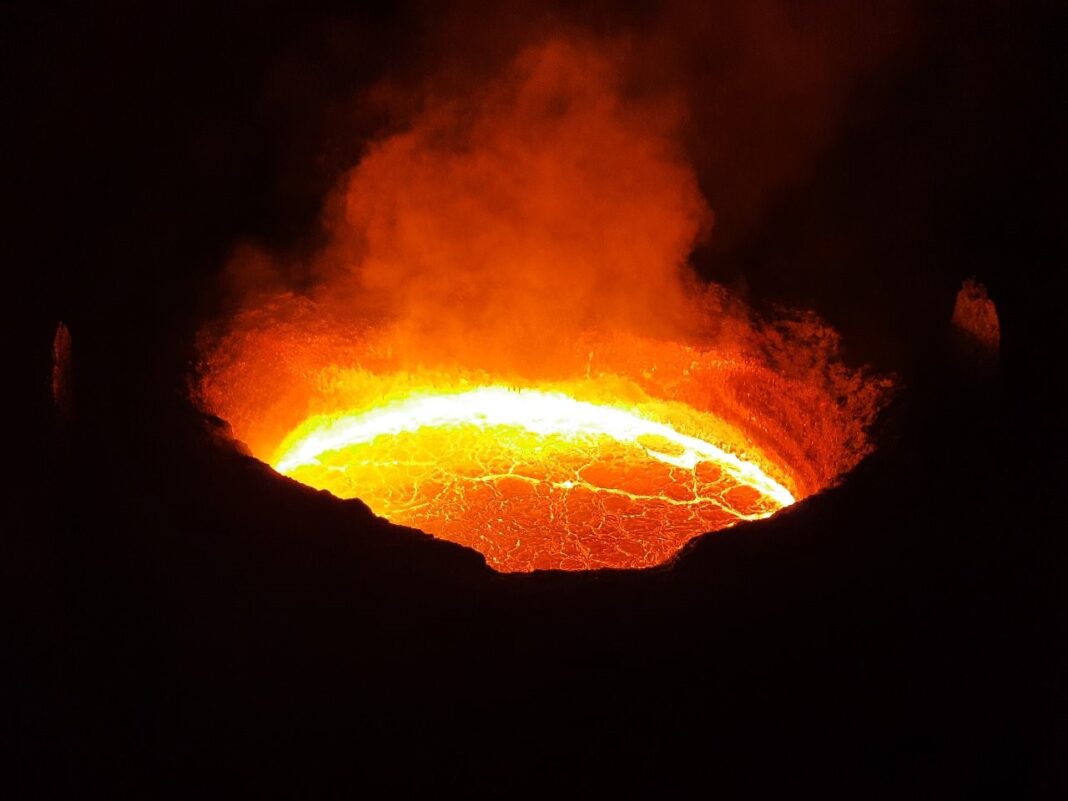With the over increasing demand for stringent quality of steel, the requirement for low sulphur concentration in steel has become an utmost requirement. Removal of S from steel is known as desulphurization. Sulphur is considered detrimental for steel in terms of surface and internal quality. It contributes to steel brittleness and lowers the melting point and intergranular strength and cohesion of steel.
Sulphur is 100 percent soluble in liquid iron but sparingly soluble in solid iron -0.002% in alpha ferrite and 0.013% in gamma ferrite at 1000 deg C. So during solidification, the solubility of S drops down and is liberated forming a eutectic of FeS around grain boundary and interdendritic spacings. This eutectic has a low eutectic temperature (988 deg C) and during rolling and forging results in hot shortness, a typical brittle fracture at hot deformation temperatures. But the formation of FeS is prevented by the addition of Manganese (Mn) which reacts with S to form MnS (m.p-1610 deg C) which prevents hot shortness. However, MnS is attributed with other problems because of its brittle nature and also acts as stress raiser and contributes towards localized strains. Thus S is detrimental in terms of ductility, impact toughness, corrosion resistance and weldability. Hence desulphurization becomes really important, which takes place primarily in the Ladle Furnace (LF).
Introduction:
In order to produce clean steel with the intent to resist the precipitation of sulphides the content of S should be kept as low as possible. The major S removal takes place during secondary steel making process. The degree of desulphurization depends on the initial concentration of oxygen and sulphur in bath, temperature, rinsing, chemical and physical properties of slag. Thus process parameters have to be controlled and optimized for obtaining low sulphur steel and concentration as low as 0.002% can be achieved from initial high S concentration of 0.06%.
Thermo chemical aspect of S removal:
Since Sulphur exhibits negative deviation in liquid so it has got a strong tendency to form FeS owing to its high affinity towards iron (Fe) but comparatively lower than that of O. So, steel has to be killed or deoxidized for effective sulphur removal.
Removal of sulphur takes place by two methods: 1.use of basic slag and 2. injection of active agents.
1.Basic slag for desulphurisation
Desulphurization using basic slag can be brought about by two mechanism:
1. Reaction takes place between basic synthetic or refining slag (which is added to the empty ladle) and the liquid steel being tapped. Energy of the falling steel stream causes intense mixing of the slag with the steel, during which sulphur is removed from the steel to slag phase.
2.But the major reaction is between the top floating slag and the metal bath due to the presence of larger contact area. This gets further enhanced by the vigorous rinsing giving rise to the formation of large number of slag droplets which gets entrained within the metal leading to high reaction kinetics. This is usually carried out by the addition of lime which helps in the formation of highly basic slag.
The main governing equation are:

Thus, higher S removal is obtained by
1. aCaO i.e higher basic slag.
2. Low aFeO i.e. Reducing atmosphere i.e. killed steel and killed slag.
3. High K which is achieved by high temperature.
4. Large surface area at slag metal interface achieved by vigorous rinsing meant to promote slag metal interaction
2.Active Agents for desulphurization:
Another method for sulphur removal is injecting metallic Ca into the bath where precipitation of CaS takes place. This reaction proceeds by direct contact between Ca wire and S in bath. At this time rinsing should be maintained in mild intensity for greater residence time of Ca in the bath and to further facilitate the floatation of CaS. Few other materials such as CaSi, CaC2, CaC2 + Mg, Lime (CaO) + Mg, Ca + Al, CaF2, Mg etc have also being used as desulphurising agents.
Common Steel Plant practices for desulphurization
Desulphurization is mainly carried out in the Secondary metallurgy area and three techniques are applied for effective S removal:
1.Synthetic slag practice
2.Lime addition
3.CaSi injection practice
80 % of desulphurization can be achieved from the original S content in secondary metallurgy area.
1.Use of synthetic slag
Use of synthetic slaghelps to meet the following requirement
· Desired basicity &sulphide capacity
· Absorb inclusions
· prevent reoxidation of steel from from atmospheric oxygen and prevent heat losses
· Prevent Hydrogen & Nitrogen pickup from atmosphere
The composition of synthetic slag is 12CaO.7Al2O3 which has optimum fluidity for metal slag interaction. Other Synthetic slags containing CaF2 which is a strong desulphuriser considered better for desulphurization. But the use of CaF2 is restricted in some plants because of the presence of Fluorine which causes severe refractory damage. Reaction takes place between basic synthetic or refining slag (which is added to the empty ladle) and the liquid steel being tapped. Energy of the falling steel stream causes intense mixing of the slag with the steel, during which sulphur is removed from the steel to slag phase. But the amount of S removal is not that substantial.
2.Lime addition
The major S removal takes place with the help of lime. Lime is generally added in batches. The slag has to be killed or the potential of O has been to be reduced for effective S removal in the form of CaS. The killing of slag is brought about by the addition of aluminium cubes owing to its higher surface area. Addition of batches of lime is preferred since excess lime addition all at a time can make the slag crusty. This can be compensated by the addition of synthetic slag which lowers the viscosity of the slag.
3. CaSi injection practice
The final step for desulphurization can be brought about by CaSi wire feeding after Al killing and before heat dispatch. This brings the S levels to below 0.005%. The CaSi serves dual purpose:
· Alumina inclusion modification which is responsible for nozzle clogging in continuous caster section.
· Formation of CaS which gets absorbed in the slag responsible for furthering lowering of S concentration.
CaSi wire feeding takes place at a speed to 250-260 m/min and the amount of addition depends on the grade of steel produced.
Normally for a 150 tons ladle 400-550 kg of synthetic slag is used for bringing initial concentration of S from 0.015-0.025 to 0.010 or less. Quantity of synthetic slag is to be regulated depending on the initial concentration of S after tapping. Ar purging is maintained at 20Nm3/min in each plug at 12 bar for 10-15mins to bring about effective desulphurization.
Some disadvantages associated with this practices are:

· Vigorous rinsing due to argon blowing leads to temperature loss due to radiation from the top bath surface and the blowing of cold argon gas.
· CaO, the main component of synthetic slag, being hygroscopic in nature leads to increase in H content in steel.
· Desulphurization becomes slow and less efficient if slag carryover is not controlled during tapping in BOF.
Conclusion:
The effective desulphurization is brought about by synthetic slags of higher basicity as basic slags contain basic oxides which have the ability to release O2- ion for replacing S in steel. Adequate temperature and rinsing are to be maintained for effective desulphurization and to speed up the process. Both are maintained high for obtaining favourable kinetics. The process gets further aided by larger rinsing time.



